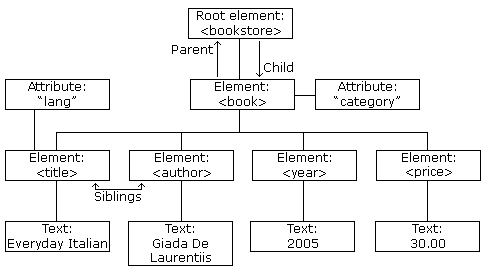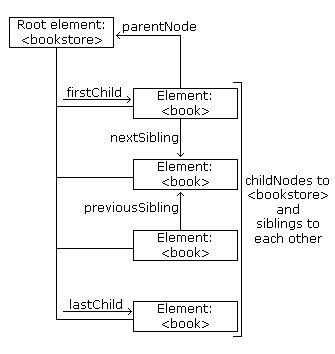XML DOM Nodes
According to the XML DOM, everything in an XML document is a node:
- The entire document is a document node
- Every XML element is an element node
- The text in the XML elements are text nodes
- Every attribute is an attribute node
- Comments are comment nodes
DOM Example
Look at the following XML file (books.xml):
<?xml version="1.0" encoding="UTF-8"?>
<bookstore>
<book category="cooking">
<title lang="en">Everyday Italian</title>
<author>Giada De Laurentiis</author>
<year>2005</year>
<price>30.00</price>
</book>
<book category="children">
<title lang="en">Harry Potter</title>
<author>J K. Rowling</author>
<year>2005</year>
<price>29.99</price>
</book>
<book category="web">
<title lang="en">XQuery Kick Start</title>
<author>James McGovern</author>
<author>Per Bothner</author>
<author>Kurt Cagle</author>
<author>James Linn</author>
<author>Vaidyanathan Nagarajan</author>
<year>2003</year>
<price>49.99</price>
</book>
<book category="web" cover="paperback">
<title lang="en">Learning XML</title>
<author>Erik T. Ray</author>
<year>2003</year>
<price>39.95</price>
</book>
</bookstore>
The root node in the XML above is named <bookstore>.
All other nodes in the document are contained within <bookstore>.
The root node <bookstore> holds 4 <book> nodes.
The first <book> node holds the child nodes: <title>, <author>, <year>, and <price>.
The child nodes contain one text node each, "Everyday Italian", "Giada De Laurentiis", "2005", and "30.00".
Text is Always Stored in Text Nodes
A common error in DOM processing is to expect an element node to contain text.
However, the text of an element node is stored in a text node.
In this example: <year>2005</year>, the element node <year> holds a text node with the value "2005".
"2005" is not the value of the <year> element!
The XML DOM Node Tree
The XML DOM views an XML document as a tree-structure. The tree structure is called a node-tree.
All nodes can be accessed through the tree. Their contents can be modified or deleted, and new elements can be created.
The node tree shows the set of nodes, and the connections between them. The tree starts at the root node and branches out to the text nodes at the lowest level of the tree:

The image above represents the XML file books.xml.
Node Parents, Children, and Siblings
The nodes in the node tree have a hierarchical relationship to each other.
The terms parent, child, and sibling are used to describe the relationships. Parent nodes have children. Children on the same level are called siblings (brothers or sisters).
- In a node tree, the top node is called the root
- Every node, except the root, has exactly one parent node
- A node can have any number of children
- A leaf is a node with no children
- Siblings are nodes with the same parent
The following image illustrates a part of the node tree and the relationship between the nodes:

Because the XML data is structured in a tree form, it can be traversed without knowing the exact structure of the tree and without knowing the type of data contained within.
You will learn more about traversing the node tree in a later chapter of this tutorial.
First Child - Last Child
Look at the following XML fragment:
<bookstore>
<book category="cooking">
<title lang="en">Everyday Italian</title>
<author>Giada De Laurentiis</author>
<year>2005</year>
<price>30.00</price>
</book>
</bookstore>
In the XML above, the <title> element is the first child of the <book> element, and the <price> element is the last child of the <book> element.
Furthermore, the <book> element is the parent node of the <title>, <author>, <year>, and <price> elements.

